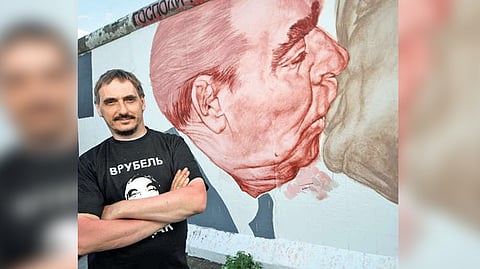

CHRISTOPHER F. SCHUETZE
CHENNAI: Dmitri Vrubel, a Russian artist-provocateur best known for a startling mural on the Berlin Wall depicting the Soviet leader Leonid Brezhnev laying a fat kiss on the mouth of the East German leader Erich Honecker, died on Saturday in Berlin. He was 62. His wife and longtime artistic partner, Victoria Timofeeva, said the cause was heart failure related to a Covid-19 infection. In 1990, the year Germany reunified, Vrubel was one of 117 artists from 21 countries to descend on a surviving stretch of the Berlin Wall, which had fallen the previous year. With paint and a ladder, he recreated a larger-than-life version of a 1979 photo of a kiss between Brezhnev and Honecker.
Below it he wrote a caption in Russian and German: “My Lord, give me the strength to survive this deadly love.”
By that time Communism was falling around the globe, and the Soviet Union was not long for this world. Honecker was out of a job, and Brezhnev was dead. But the mural took on a life of its own as a subversive commentary on the dissolute ways of a dying system. “More than any other work of art, it symbolizes the peaceful triumph over the seedy empire of antiquated Communist leaders,” the German newspaper Spiegel wrote in 2009.
The Berlin daily Tagesspiegel called it “a symbol of peace, love and transgression of all kinds.” The image became an emblem of the freewheeling, graffitied, artistic Berlin of the 1990s. More than three decades on, it remains one of the most photographed murals in Berlin and is replicated on countless T-shirts, mugs and postcards. Vrubel said he copied the image from a picture he saw in the French magazine Paris Match. The photograph was taken by the French photojournalist Régis Bossu in 1979 in East Berlin, just a few miles from where it would later become famous, on the occasion of East Germany’s 30th anniversary.
Although the sight of two elderly heads of state engaging in a sloppy kiss on the mouth was shocking to many modern Western viewers, many of whom assumed the image was purely the creation of the artist’s imagination, the gesture was a certain tradition among Communist leaders, who used it to symbolize their solidarity.
Friends thought Vrubel was crazy for wanting to paint on the Berlin Wall, a relic of a bygone era, he recounted in a 2013 interview with the government-funded Goethe Institute. But he knew he was onto something. “I had no doubts about it,” he said. “It was just very fun.” Indeed, the painting’s satirical simplicity and power to shock were so resonant that it has often been copied, with other leaders subbing in for Brezhnev and Honecker.
After Russia invaded Ukraine in February, the mural was temporarily covered by a canvas painting depicting Gerhard Schröder, the former German chancellor-turned-Russian energy lobbyist, embracing President Vladimir Putin of Russia. After painting his Berlin mural, Vrubel returned to Moscow in 1990 and found some success there in 2001 with a limited-edition calendar capturing 12 moods of Putin. In 2009, long after his mural had become a must-see stop on any Berlin itinerary, he returned to Berlin to repaint it. But he will be forever known for one work, which had come to him in an instant. “When I first saw the Berlin Wall, I knew exactly what I wanted to paint: Brezhnev and Honecker,” he said in the 2013 interview. “A picture for Berlin,” he added, “for the Germans.”
Schuetze is a journalist with NYT©2022
The New York Times
Visit news.dtnext.in to explore our interactive epaper!
Download the DT Next app for more exciting features!
Click here for iOS
Click here for Android